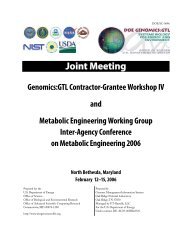Joint Meeting - Genomics - U.S. Department of Energy
Joint Meeting - Genomics - U.S. Department of Energy
Joint Meeting - Genomics - U.S. Department of Energy
Create successful ePaper yourself
Turn your PDF publications into a flip-book with our unique Google optimized e-Paper software.
14<br />
Systems Biology for DOE <strong>Energy</strong> and Environmental Missions<br />
based on infrared absorption and spontaneous Raman<br />
scattering have been used for chemically selective imaging.<br />
However, IR microscopy is limited to low spatial<br />
resolution because <strong>of</strong> the long wavelength <strong>of</strong> light used.<br />
Furthermore, the absorption <strong>of</strong> water in the infrared<br />
region makes it difficult to image biological materials.<br />
Raman microscopy can overcome these limitations and<br />
has been successfully used to characterize plant cell walls.<br />
By tuning into different vibrational frequencies, lignin<br />
and carbohydrates could be imaged selectively. However,<br />
the intrinsically weak Raman signal can require high laser<br />
powers and long integration times, <strong>of</strong>ten hours. This poor<br />
time resolution prevents any kind <strong>of</strong> real time monitoring.<br />
Coherent anti-Stokes Raman scattering (CARS) microscopy<br />
has matured as a powerful nonlinear vibrational<br />
imaging technique that overcomes these limitations <strong>of</strong><br />
conventional Raman microscopy [3,4]. CARS microscopy<br />
provides a contrast mechanism based on molecular<br />
vibrations, which are intrinsic to the samples. It does not<br />
require natural or artificial fluorescent probes. CARS<br />
microscopy is orders <strong>of</strong> magnitude more sensitive than<br />
spontaneous Raman microscopy. Therefore, CARS<br />
microscopy permits fast vibrational imaging at moderate<br />
average excitation powers (i.e. up to ~10 mW) tolerable<br />
by most biological samples. Furthermore, CARS microscopy<br />
has a three-dimensional sectioning capability, useful<br />
for imaging thick tissues or cell structures. This is because<br />
the nonlinear CARS signal is only generated at the focus<br />
where the laser intensities are the highest. Finally, the<br />
anti-Stokes signal is blue-shifted from the two excitation<br />
frequencies, and can thus be easily detected in the<br />
presence <strong>of</strong> one-photon fluorescence background. We<br />
demonstrate that CARS can visualize the chemical and<br />
structural changes <strong>of</strong> the cell walls during this conversion<br />
process.<br />
The Raman spectrum <strong>of</strong> a cell wall region in corn stover<br />
is shown in Fig. A (inset). The prominent band at 1600<br />
cm -1 is the aryl symmetric ring stretching vibration which<br />
serves as a sensitive marker for the presence <strong>of</strong> lignin.<br />
The two bands at around 1090 and 1110 cm -1 are due<br />
to C-O and C-C stretching vibrations from cellulosic<br />
polymers at the cell wall. The structures <strong>of</strong> lignin and<br />
cellulose are shown in Fig. B. Figure a shows the CARS<br />
image tuned into the lignin band at 1600 cm -1 . A high<br />
density <strong>of</strong> the lignin is detected in the secondary cell<br />
walls. The integration time <strong>of</strong> a CARS image (Fig. d) is<br />
with 20 sec tremendously faster than compared to the<br />
Raman picture that requires about 55 min (Fig. c), while<br />
providing a comparable contrast. The fast integration<br />
time is critical <strong>of</strong> monitoring chemical changes during<br />
biomass pretreatment that usually occurs within minutes.<br />
* Presenting author<br />
Currently, we are working on improving the sensitivity <strong>of</strong><br />
the CARS technique to image cellulose, as well as spatial<br />
resolution. These initial results demonstrate the feasibility<br />
<strong>of</strong> the proposed method.<br />
Figure. a) CARS images <strong>of</strong> cross section <strong>of</strong> corn stove<br />
cell walls by integrating over the aromatic lignin band<br />
wavelength (1,550–1,640 cm-1). b) Chemical Structures<br />
<strong>of</strong> lignin and cellulose. c) Cross section <strong>of</strong> poplar wood<br />
imaged by Raman microscopy (integration time <strong>of</strong><br />
55 min) and d) CARS microscopy (integration time <strong>of</strong><br />
20sec).<br />
References<br />
1. Ding, S.-Y. & Himmel, M. E. (2006) The Maize<br />
Primary Cell Wall Micr<strong>of</strong>ibril: A New Model Derived<br />
from Direct Visualization. J. Agric. Food Chem.<br />
54, 597-606.<br />
2. Himmel, M. E., Ding, S.-Y., Johnson, D. K., Adney,<br />
W. S., Nimlos, M. R., Brady, J. W., & Foust, T. D.<br />
(2007) Biomass Recalcitrance: Engineering Plants<br />
and Enzymes for Bi<strong>of</strong>uels Production. Science 315,<br />
804-807.<br />
3. Zumbusch, Andreas; Holtom, Gary R.; Xie, X. Sunney<br />
(1999) Vibrational Microscopy Using Coherent<br />
Anti-Stokes Raman Scattering, Phys. Rev. Lett. 82,<br />
4142.<br />
4. Cheng, Ji-Xin and Xie, X. Sunney (2004) Coherent<br />
anti-Stokes Raman scattering microscopy: instrumentation,<br />
theory and applications, J. Phys. Chem. B<br />
108, 827.





